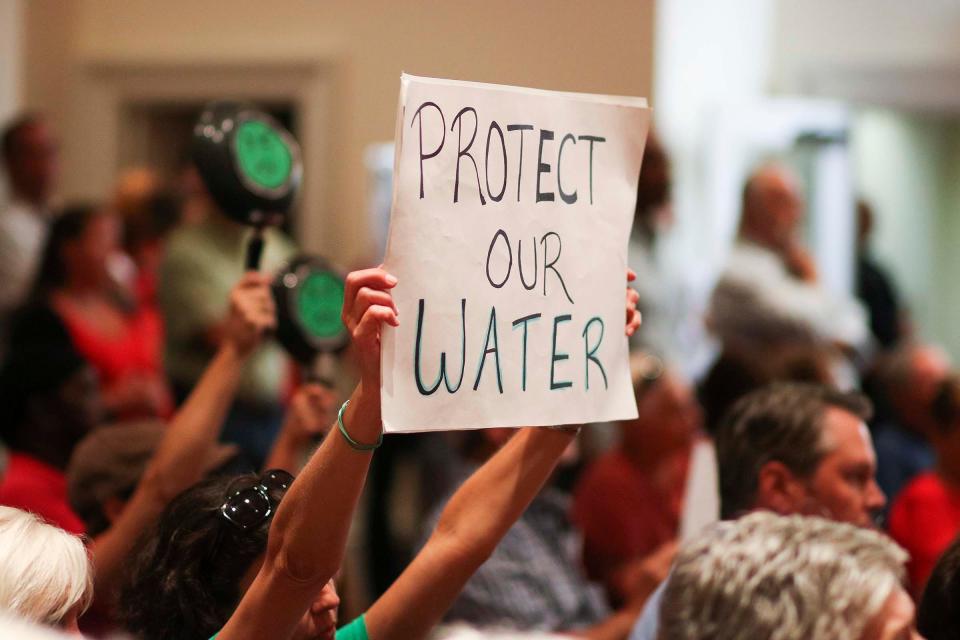Years after PFAS rocks Bucks County, Montco towns, EPA sets near-zero detection limit
- Oops!Something went wrong.Please try again later.
For the past eight years, the lack of a federal limit on drinking water contamination for a family of chemicals known as PFAS left thousands of residents in Warrington, Warminster and Horsham with little recourse to hold polluters accountable.
Local environmental advocates like the Buxmont Coalition for Clean Water scored a major victory in their near-decade fight Wednesday with the Environmental Protection Agency issuing strict Maximum Contaminant Levels for the so-called “forever chemicals."
Joanne Stanton and Hope Grosse, founders of the local clean drinking water group and leading PFAS advocates, said the new regulations were a historic victory for millions of Americans exposed to the compounds linked to a number of health affects, including cancer.

Stnaton and Grosse joined several other advocates and lawmakers on a press call Wednesday applauding the Biden Administration for passing the new regulations.
PFAS in Bucks, Montgomery counties: PFAS in Bucks County and Montco: Some residents test high for 'forever chemicals' near bases
“The EPA followed the science and set the MCL at close to non-detect; sending a strong message to polluters, like the Department of Defense, that these toxic ‘forever chemicals’ have no safe level,” Stanton said Wednesday.
EPA sets standard for 'forever chemicals'
The EPA’s National Primary Drinking Water Regulations set standards for six PFAS compounds, known as forever chemicals because the relatively heavy chemicals can remain in a person’s bloodstream indefinitely after exposure.
The MCL for PFOA and PFOS, two of the most common compounds, is 4 parts per trillion. Four other PFAS compounds — PFNA, PFHxS, PFBS and Gen X chemicals — each of an MCL of 10 ppt.
Those four compounds will also be regulated as a mixture, with an MCL of 4 ppt if a combination of the chemicals are found in public drinking water supplies.
For more technical details and facts about the rule and the dangers and known health effects of PFAS exposure see EPA’s link here: https://www.epa.gov/sdwa/and-polyfluoroalkyl-substances-pfas.
In March, the EPA released data finding that the drinking water for at least 70 million Americans comes from sources contaminated with PFAS.
“This drinking water regulation will save lives and prevent others from the needless suffering my family and my community has suffered at the hands of these toxic chemicals,” Grosse said. “No one should have to live in fear that every ache or pain in their body will end up being a cancer diagnosis that could have been prevented through more rigorous drinking water standards.”

What is PFAS?
The formerly unregulated chemicals were first invented in the 1940s and became nearly ubiquitous compounds used in consumer and industrial products for decades.
Over the years, PFAS have been linked to different types of cancer, low birth weights, thyroid disease and other health conditions.
Previous research has suggested widespread PFAS contamination has been a problem for decades; some recent estimates suggest about 96% of Americans currently have some level of PFAS in their blood.
The EPA first began testing water supplies for PFAS around 2014 as part of a national program investigating emerging contaminants with potential health risks.
In 2016, the EPA set a Health Advisory Level of 70 ppt for PFOA and PFOS, but wells tested in the three Bucks and Montgomery towns tested at levels up to several hundred times those levels.
EPA rule targes PFAS in chemical plants New EPA rule says over 200 US chemical plants must reduce toxic emissions linked to cancer
The results led to a mass shutdown of private and public drinking water wells that impacted roughly 70,000 residents living near three former and active military bases near the county border: the former Naval Air Station-Joint Reserve Base Willow Grove, the current Horsham Air Guard Station and the former Naval Air Warfare Center.
While the military was the primary source of pollution locally, the nonprofit Environmental Working Group has a documented timeline showing that major PFAS manufacturers DuPont and 3M knew of the potential health risks of PFAS since the 1950s.
“They have known for some 70 years, more than my lifetime, that these chemicals could not be broken down … yet they did nothing,” Democratic Congresswoman Madeleine Dean, PA-04, said during a press conference Wednesday afternoon.
Why were the MCLs needed?
Dean said Wednesday afternoon that the MCLs were long-needed rule to give “teeth” to regulators and victims of PFAS contamination.
“For years we have been living under a Health Advisor Level without any teeth … but this federal MCL, set by the EPA, is lower and will ensure that communities everywhere can be better protected,” Dean said.
While the EPA in 2022 implemented a new HAL that was 17,000 times lower than the 70 ppt level set in 2016, the previous advisory levels set were not legally enforceable
Due to the lack of regulations, local lawmakers at every level of government since 2016 have had to pressure the military to reimburse residents for the costs provide drinking water free of any PFAS contamination.
The federal government initially only agreed to repay costs to bring PFAS levels down to 70 ppt, though a state law introduced in 2019 by former State Rep. Todd Stephens found a way to remit the local costs through state tax dollars with the ultimate goal of the military repaying the state later on.
In 2021, the Navy successfully had two lawsuits tossed out over lack of state or federal PFAS limits.
The Giovanni family, of Warrington, and the Palmer family, of Ivyland, had been seeking court-mandated monitoring of wells, but the Navy argued the suit must be dismissed because PFAS are not considered “hazardous substances” under state law.
It wasn’t until Jan. 14, 2023, that the state’s Department of Environmental Protection set its own MCLs of 14 ppt for PFOA and 18 ppt for PFOS, a limit that environmental group The Delaware Riverkeeper Network criticized as being too lenient.
New Jersey's PFAS limits: New Jersey approves drinking water standards for toxic PFAS chemicals. Will legal battles follow?
Riverkeeper Deputy Director Tracy Carluccio said Wednesday’s federal rules were a “monumental step” towards “a just goal of providing all people across our nation with reliably safe drinking water.”
A news release from the EPA estimates that between about 6% and 10% of 66,000 drinking water systems subject to the new rules may have to take action to reduce PFAS to meet the new standards.
The EPA also announced Wednesday $1 billion in funding through the Bipartsian Infrastructure Law to help states and terroitories implement PFAS testing and for water treatment and help owners of private wells. The funds are part of a $9 billion investment to address PFAS and other emerging contaminants. Another $12 billion is also available for general drinking water improvements through the infrastructure law.
All public water systems will have three years to complete their initial monitoring for PFAS and inform the public of the level of PFAS measured in their drinking water.
Where PFAS is found above the MCL, those systems must take steps to bring levels down within five years.
Chris Ullery is the Philadelphia Hub Data Reporter for the USA Today Network. Reach him at cullery@couriertimes.com or find him on Twitter at @ulleryatinell.
This article originally appeared on Bucks County Courier Times: New EPA rule sets limits on PFAS forever chemicals in drinking water

